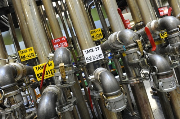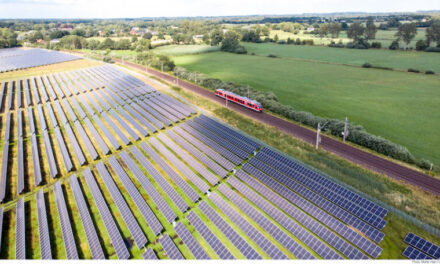 Simon Ellam from Siemens, claims that the best way for process industries to tackle the amount of energy they consume and understand how they use it, is to formulate a three phase strategy based upon the intelligence provided by process automation technology.
Simon Ellam from Siemens, claims that the best way for process industries to tackle the amount of energy they consume and understand how they use it, is to formulate a three phase strategy based upon the intelligence provided by process automation technology.
Energy is the second largest cost factor in the process industry after raw materials, and these cost will only intensify in the future as the price of energy is forecast to remain high. Therefore, improvements in energy efficiency can have a number of business benefits – not the least as an aid to profitability and competitiveness. For UK manufacturers the issue of energy management remains key, but also one that presents many challenges.
Examples from Siemens’ The Green League research (see Energy Management Spring 2012) support the belief that we still have some way to go to ensure businesses are on top of the energy management conundrum.
The research paints a mixed picture, with some organisations further ahead than others when it comes to both understanding energy use levels, and then implementing energy management measures to ensure rising costs do not adversely affect any competitive advantage.
Process automation
One of the key areas where big inroads can be made into energy saving targets for industrial plants is the utilisation of intelligent process automation – with estimates that energy savings of 15% can be achieved.
The term energy management system encompasses the organisational and information structures, including the required tools (e.g hardware and software) needed to implement energy management. In the stricter sense it is a technical system for gathering, analysing, documenting and visualising energy data, as well as regulating and monitoring energy consumption in plants.
Energy management in a production plant is not primarily a product, but more a permanent process of improvement comparable with quality management. When improving energy efficiency and conservation of resources, adopting a holistic consideration of the plant as well as of the product life cycles in the context of energy management, can prove beneficial. In this respect, the intelligent combination of end to end processes, targeted services and an integrated technology portfolio offers great potential.
At Siemens, this approach is based on the three phases of ‘identification’, ‘evaluation’ and ‘implementation’. The ‘identification’ phase is a matter of using appropriate automation hardware and software to detect the energy flows in the plant and to enable identification of the high areas of energy consumption. This involves targeted and consistent recording of energy data as process parameters, starting with the sensors and actuators, then proceeding through the control level to the management control level.
In the ‘evaluation’ phase the potential savings are calculated. The third phase of ‘implementation’ involves leveraging the agreed potential savings by means of firm actions. It is worth noting here that special attention should be applied to drive technology which accounts for around two thirds of industrial energy consumption.
Continuous energy management results in a lasting increase in productivity – through energy saving, continuous load management, the compensation for peaks in energy demand by means of load shifting and the planning of the energy demand for the process plant. This is because productivity potential can no longer be optimised just by means of more efficient isolated solutions. There is a much greater necessity for the seamless horizontal and vertical integration of information, communication and automation technologies into the operating processes.
Energy management in practice
At the field level it is a matter on the one hand of recording energy consumption, taking into account both electrical and non-electrical forms of energy, and on the other hand the minimisation of energy consumption through the use of energy efficient devices such as motors, frequency converters, soft starters, switching and protection devices, as well as power supplies.
At the control level it not only involves the collection, aggregation and preparation of the energy consumption data from the field level, but also the minimisation of the energy consumption by optimising the process management with the aid of advanced process control and asset management functions.
At the operator control and monitoring level it involves visualising the consumption data with characteristic values, graphs and other graphical presentations, but also the archiving of energy data and the generation of reports by unit, batch or plant section as required.
Finally, at the management level, it is a case of planning and procuring the energy, and of controlling and monitoring the energy whereby a clever combination of load management and time or load dependent tariff systems enables the procurement costs to be minimised.
The requirement for increasingly efficient use of energy is set to intensify over the coming years. For businesses trying to manage costs, operate effectively and compete in tough markets, it could be that the success an organisation enjoys in tackling its energy needs and optimising the intelligence process automation technology can deliver, will be a significant factor that sets it apart from the competition.
Simon Ellam from Siemens, claims that the best way for process industries to tackle the amount of energy they consume and understand how they use it, is to formulate a three phase strategy based upon the intelligence provided by process automation technology
Energy is the second largest cost factor in the process industry after raw materials, and these cost will only intensify in the future as the price of energy is forecast to remain high. Therefore, improvements in energy efficiency can have a number of business benefits – not the least as an aid to profitability and competitiveness. For UK manufacturers the issue of energy management remains key, but also one that presents many challenges.
Examples from Siemens’ The Green League research (see Energy Management Spring 2012) support the belief that we still have some way to go to ensure businesses are on top of the energy management conundrum.
The research paints a mixed picture, with some organisations further ahead than others when it comes to both understanding energy use levels, and then implementing energy management measures to ensure rising costs do not adversely affect any competitive advantage.
 Process automation
Process automation
One of the key areas where big inroads can be made into energy saving targets for industrial plants is the utilisation of intelligent process automation – with estimates that energy savings of 15% can be achieved.
The term energy management system encompasses the organisational and information structures, including the required tools (e.g hardware and software) needed to implement energy management. In the stricter sense it is a technical system for gathering, analysing, documenting and visualising energy data, as well as regulating and monitoring energy consumption in plants.
Energy management in a production plant is not primarily a product, but more a permanent process of improvement comparable with quality management. When improving energy efficiency and conservation of resources, adopting a holistic consideration of the plant as well as of the product life cycles in the context of energy management, can prove beneficial. In this respect, the intelligent combination of end to end processes, targeted services and an integrated technology portfolio offers great potential.
At Siemens, this approach is based on the three phases of ‘identification’, ‘evaluation’ and ‘implementation’. The ‘identification’ phase is a matter of using appropriate automation hardware and software to detect the energy flows in the plant and to enable identification of the high areas of energy consumption. This involves targeted and consistent recording of energy data as process parameters, starting with the sensors and actuators, then proceeding through the control level to the management control level.
In the ‘evaluation’ phase the potential savings are calculated. The third phase of ‘implementation’ involves leveraging the agreed potential savings by means of firm actions. It is worth noting here that special attention should be applied to drive technology which accounts for around two thirds of industrial energy consumption.
Continuous energy management results in a lasting increase in productivity – through energy saving, continuous load management, the compensation for peaks in energy demand by means of load shifting and the planning of the energy demand for the process plant. This is because productivity potential can no longer be optimised just by means of more efficient isolated solutions. There is a much greater necessity for the seamless horizontal and vertical integration of information, communication and automation technologies into the operating processes.
Energy management in practice
At the field level it is a matter on the one hand of recording energy consumption, taking into account both electrical and non-electrical forms of energy, and on the other hand the minimisation of energy consumption through the use of energy efficient devices such as motors, frequency converters, soft starters, switching and protection devices, as well as power supplies.
At the control level it not only involves the collection, aggregation and preparation of the energy consumption data from the field level, but also the minimisation of the energy consumption by optimising the process management with the aid of advanced process control and asset management functions.
At the operator control and monitoring level it involves visualising the consumption data with characteristic values, graphs and other graphical presentations, but also the archiving of energy data and the generation of reports by unit, batch or plant section as required.
Finally, at the management level, it is a case of planning and procuring the energy, and of controlling and monitoring the energy whereby a clever combination of load management and time or load dependent tariff systems enables the procurement costs to be minimised.
The requirement for increasingly efficient use of energy is set to intensify over the coming years. For businesses trying to manage costs, operate effectively and compete in tough markets, it could be that the success an organisation enjoys in tackling its energy needs and optimising the intelligence process automation technology can deliver, will be a significant factor that sets it apart from the competition.




